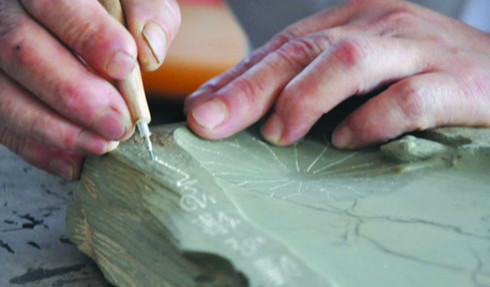Qingdao resident shares enthusiasm for ink slabs
- By Liu Sitong
 0 Comment(s)
0 Comment(s) Print
Print E-mail China.org.cn, November 27, 2017
E-mail China.org.cn, November 27, 2017
Pan Mingcan in Jimo district of Qingdao has a passion for ink slab, one of the four basic and most important pieces of stationery in ancient times that enjoyed long-lasting love of traditional Chinese scholars.
Pan’s love for ink slabs derived from his practice of calligraphy. For some 20 years, he has collected and craved a large amount of ink slabs. Boutique ink slabs take up most of the space of his house, while all sorts of implements for ink slab carving are placed in a back room where he works on ink slabs.
Pan said that although not listed in one of the four most famous ink slabs, Shandong ink slabs have nearly 20 varieties. The ink slabs he creates are mainly literati-style ink slabs that are engraved with verses to express one’s inner world.

To seek treasured ink slabs, Pan have travelled across the country, including Jilin province in the northeast and Shanghai to the south, following leads he overheard or discovered online. He reached out to ink slab aficionados nationwide to learn from their experiences.
Pan used stones from Mashan Mountain nature reserve in western Jimo, where volcanic rock, metamorphic rock and sedimentary rock can be found, to carve a dozen of ink slabs. The nature reserve has long been under protection, what Pan used in ink slab carving are the ones used as construction materials in the past. The grayish green stones are difficult to carve for their hardness but the ink slabs made of these stones produce fine inks for writing.
Wugong Stone from Yinan county is another material Pan favors. It is a type of limestone, easy to work on. Pan created many ink slabs with this material, most of which have been given out. Among the few he still keeps is a peach-themed ink slab that took him half a month to observe before started carving. The plain of the ink slab, a surface on which ink sticks are ground against to produce inks, is peach-shaped; the edges carry patterns of peach leaves which interlude with peach-themed lines of verse.
The colorful Songhua Stone, used to be royal tributes in Qing Dynasty (1644-1911), found in the Songhua River basin across Liaoning and Jilin provinces, also inspired Pan to create many ink slab works.
Pan takes ink slab carving seriously as a means to promote traditional culture. But it could be expensive and time-consuming. In the process Pan sometimes has difficulty in making ends meet, it was his family that offered the support he needs to pursue his passion.

Pan said that there is a lot to learn to make exquisite ink slabs, including masonry, carpentry, benchwork, calligraphy, poetry, and artistic design, and that he will continue to produce quality ink slabs as long as his health allows.




Go to Forum >>0 Comment(s)